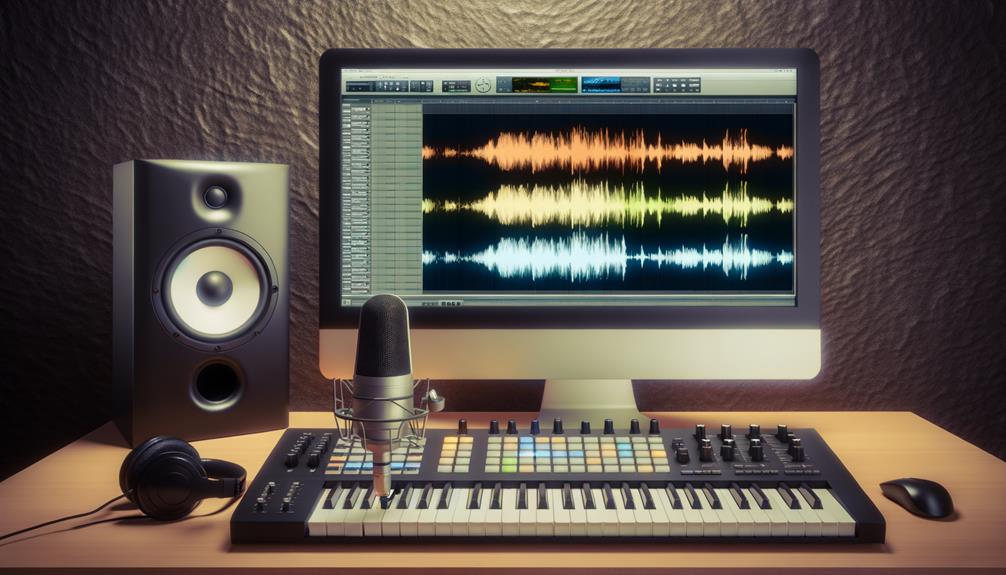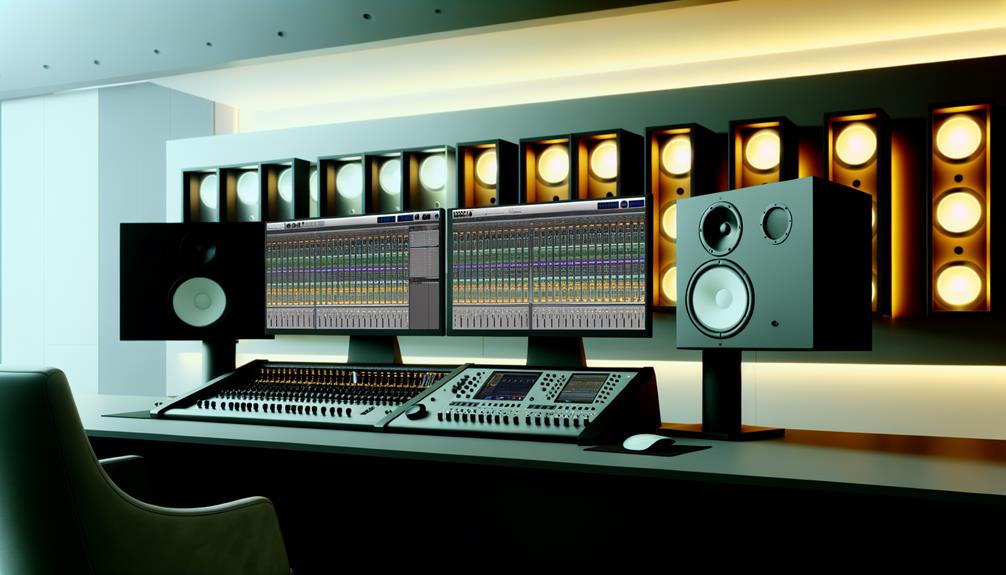No products in the cart.
To master effectively in Pro Tools, first make sure you set appropriate levels and utilize dynamic compression for consistent volume. Focus on mastering EQ by refining the frequency spectrum, enhancing sound clarity and addressing problematic frequencies. Employ subtle compression techniques; use a low ratio and slow attack for a more natural sound, adjusting release times to your track’s tempo. Improve stereo imaging by adjusting width and employing mid-side processing for a spacious soundstage. Don’t forget to experiment with reverb and delay to add depth and texture. These foundations will get you started, but there’s much more to explore as you hone your skills.
Contents
hide
Key Takeaways
- Utilize Pro Tools’ built-in dynamic range compression to maintain consistent levels throughout the track.
- Employ the EQ tools in Pro Tools to enhance clarity and balance across frequencies.
- Experiment with Pro Tools’ advanced stereo imaging features to create a spacious and immersive soundstage.
- Integrate subtle reverb and delay effects in Pro Tools to add depth and texture to your mastering.
- Leverage automation in Pro Tools to refine dynamics and levels with precision throughout the mastering process.
Optimize Your Levels and Dynamics
To optimize your levels and dynamics in Pro Tools, set appropriate levels to avoid distortion and guarantee an ideal signal-to-noise ratio during mastering. You’ll need to focus on peak control to manage the loudest parts of your track effectively. This ensures that the audio doesn’t clip, maintaining the integrity of your sound throughout the mastering process.
Achieving consistent levels is important. Utilize dynamic range compression to even out the levels across your track. By compressing the dynamic range, you tame the overly loud and quiet parts, leading to a more uniform and professional sound. Be cautious not to overcompress, as this can lead to a lifeless mix. Instead, aim for a balance that enhances the musical dynamics without squashing them.
Incorporate automation to refine the dynamics and levels further. Automation allows you to make precise adjustments to volume, panning, and effects throughout your track. This tailored approach helps in addressing specific parts of your audio that may need dynamic adjustment, ensuring that every section of your track is well-balanced and polished.
Master EQ for Clearer Sound
Mastering EQ is vital for refining the frequency spectrum of your track, ensuring each element stands out with clarity and precision. When you’re mastering in Pro Tools, your ability to manipulate the EQ settings is essential for frequency sculpting. By carefully adjusting the low, mid, and high frequencies, you’ll not only balance the track but also enhance the overall sound quality.
To achieve this, focus on identifying and targeting problem frequencies. If there’s a muddiness in the low end, you might need to cut some frequencies to clarify the bass and kick drum. For vocals that need to pop more, gently boost the high-mid frequencies. This precise cutting and boosting allow for significant sound enhancement, bringing forth the detail and separation that makes professional tracks stand out.
Techniques for Subtle Compression
After refining your track’s frequency spectrum with Master EQ, consider using subtle compression techniques to further control dynamics without sacrificing the natural sound. In Pro Tools, start with a low compression ratio. You’re aiming for gentle control, so a ratio of 1.5:1 or 2:1 often works well. This setting helps to tame loud sections without squashing the overall dynamics of your track.
For a more transparent effect, set a slow attack time. This allows the initial transients, the punchy part of your sound, to pass through unaffected. Transient shaping can be critical here; it fine-tunes the attack of sounds like drums or plucked strings to maintain their natural character. Adjust the release time to match the song’s tempo, ensuring the compression breathes with the music rather than stifling it.
Don’t forget the makeup gain to compensate for any volume loss. This step is essential to maintain a consistent level across your mix.
Explore parallel processing to blend the compressed signal with the original, preserving dynamics while achieving a fuller sound. Similarly, multiband compression can target specific frequency ranges, offering more control and precision. Lastly, consider using sidechain compression to subtly duck competing elements, enhancing clarity without obvious compression artifacts.
Enhance Stereo Imaging
Enhancing stereo imaging in your mix allows you to craft a spacious and immersive soundstage. To start, consider adjusting the stereo width using plugins designed for this purpose, such as iZotope Ozone Imager or Waves S1 Imager. These tools are pivotal for stereo width manipulation and employ creative techniques that expand or narrow the stereo field effectively. However, use these methods sparingly, as excessive widening can lead to phase cancellation issues, which might degrade your mix’s quality on mono playback systems.
Mid-side processing offers advanced tactics for more granular control. This technique allows you to manage the side (stereo) and mid (mono) components independently, tailoring the spread of your stereo image with precision. By enhancing elements in the side channel, you can achieve a fuller, more dynamic stereo effect without affecting the central focus of your mix, which resides in the mid channel.
As you apply these strategies, it’s essential to reference professional tracks. Analyzing well-mastered music helps you gauge the effectiveness of your stereo imaging and provides practical benchmarks for your work. Remember, the goal is to create a balanced, clear, and engaging auditory experience.
Experiment With Reverb and Delay
To add depth and space to your mix, experiment with different reverb types like plate, hall, room, and spring. Each type offers unique characteristics that can transform your track’s spatial perception. Plate reverb provides a smooth decay that’s ideal for vocals, while hall reverb adds a grand scale, suitable for orchestral pieces. Room reverb can emulate a tighter, more intimate space, and spring reverb introduces a distinctive twang that works well with guitar and retro pop tracks.
Incorporating delay can further enhance the rhythmic complexity and spatial manipulation of your tracks. Use delay to create echoing effects that complement the tempo and rhythm, adding a dynamic layer to your audio landscape. By adjusting the delay time, you can sync these echoes with your musical elements, providing a cohesive listening experience.
Creative blending of reverb and delay allows for richer, more atmospheric mastering. Tweak the pre-delay, decay time, and wet/dry mix to fine-tune these effects to your taste. Don’t shy away from integrating modulation effects like chorus, flanger, and phaser with your reverb and delay setups. This combination can yield deep, immersive textures, elevating your mastering project to professional standards.
Frequently Asked Questions
How to Do Mastering in Pro Tools?
To master in Pro Tools, first set up your session with reference tracks. Carefully select plugins—EQ, compression, limiting—for your Master Fader Inserts. Focus on maintaining levels and checking mono compatibility.
Is Pro Tools Good for Mixing and Mastering?
Yes, Pro Tools is exceptional for mixing and mastering due to its versatility and wide industry adoption. Its precise editing capabilities and robust plugin support guarantee high-quality audio for professional projects.
What Are the Basic Mastering Techniques?
Mastering involves key techniques like equalization basics and compression settings. You’ll also use limiting, stereo enhancement, and dithering to refine tracks. Each step guarantees your music sounds polished across various playback systems.
What Should I Aim for When Mastering?
When mastering, you should aim for dynamic consistency and tonal balance. Optimize dynamics, enhance stereo width, and carefully adjust EQ. Don’t forget dithering to maintain audio quality and minimize quantization errors.
Conclusion
Now that you’ve explored the essentials of mastering with Pro Tools, you’re ready to enhance your tracks. Remember, balancing your levels and dynamics sets the foundation.
Use master EQ to clarify your sound, apply subtle compression wisely to maintain energy, and refine stereo imaging for depth.
Don’t hesitate to experiment with reverb and delay for spatial enhancement. With these techniques, you’ll achieve professional, polished results that make your music stand out.
Immerse yourself and perfect your sound!




